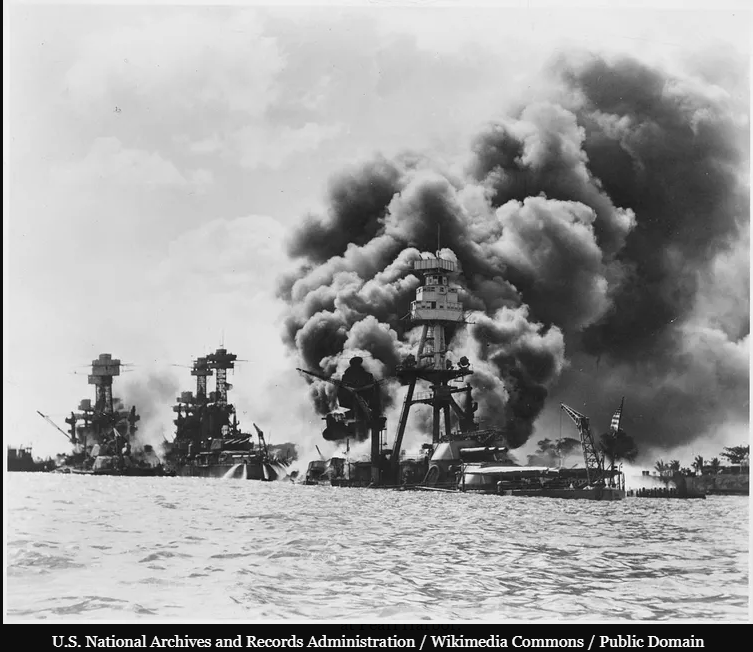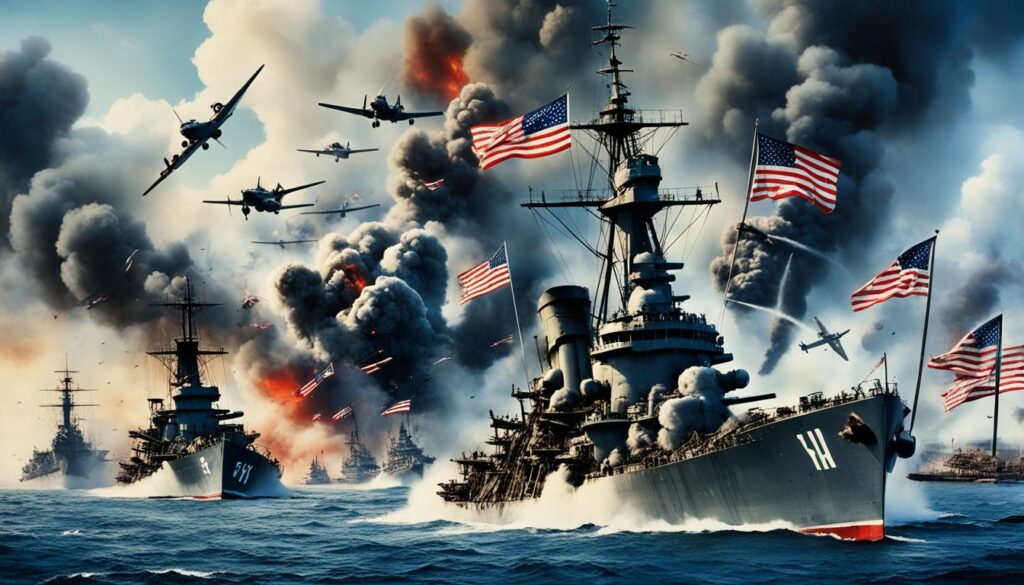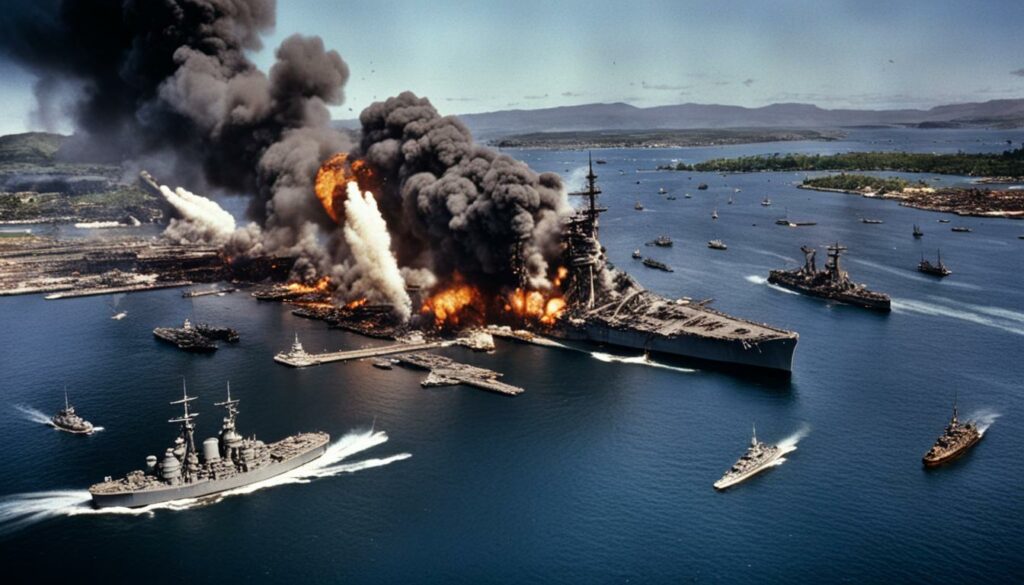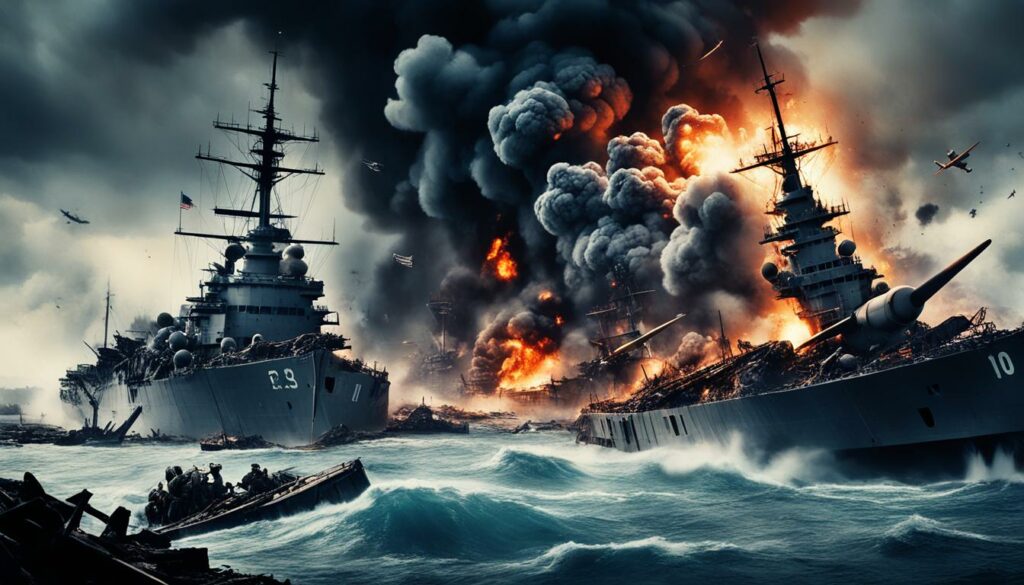Physical Address
304 North Cardinal St.
Dorchester Center, MA 02124
Physical Address
304 North Cardinal St.
Dorchester Center, MA 02124

On December 7, 1941, over 2,400 American lives were lost in a surprise attack by Japan at Pearl Harbor, Hawaii. This event, known as the “Pearl Harbor Attack,” changed history. It changed World War II and the U.S.-Japan relationship forever.

On December 7, 1941, the attack on Pearl Harbor by the Imperial Japanese Navy shocked the world. This surprise offensive caught the United States Pacific Fleet and other military bases in Hawaii by surprise. The devastating impact of this attack changed history forever.
The Japanese forces launched a series of coordinated air strikes against the U.S. Pacific Fleet. This led to huge damage and loss of life. Over 2,400 American servicemen were killed, and nearly 1,200 others were wounded. The attack also sank or damaged 21 ships, including 8 battleships, and destroyed 188 aircraft. This devastating blow to the U.S. military led to America joining World War II.
The Pearl Harbor attack was a well-planned surprise offensive by the Imperial Japanese Navy. Japanese forces launched coordinated air strikes against the U.S. Pacific Fleet and military bases in Hawaii. The Americans were completely caught off guard.
The attack on Pearl Harbor caused huge devastation and loss of life. Over 2,400 American servicemen were killed, and nearly 1,200 others were wounded. The attack also sank or damaged 21 ships, including 8 battleships, and destroyed 188 aircraft. This devastating blow to the U.S. military led to America joining World War II.
“The attack on Pearl Harbor was a carefully planned and executed surprise offensive by the Imperial Japanese Navy, resulting in catastrophic damage and loss of life for the United States.”
| Statistic | Impact |
|---|---|
| American Servicemen Killed | Over 2,400 |
| American Servicemen Wounded | Nearly 1,200 |
| Ships Sunk or Damaged | 21, including 8 battleships |
| Aircraft Destroyed | 188 |
The Pearl Harbor attack on December 7, 1941, changed everything. It made the United States join World War II. President Franklin D. Roosevelt called it “a date which will live in infamy.” The next day, Congress declared war on Japan, making America part of the global fight.
This event was a big change for America. Before, the country wanted to stay out of other countries’ wars. But after the attack at Pearl Harbor, with over 2,400 Americans killed, joining the Allies was the only choice.
The U.S. entry into World War II was a key moment in history. It changed the war’s course and led to the Allies’ victory. America’s role in the war had big effects, both worldwide and at home.
“Yesterday, December 7, 1941—a date which will live in infamy—the United States of America was suddenly and deliberately attacked by naval and air forces of the Empire of Japan.” – President Franklin D. Roosevelt
When the U.S. joined World War II, the Pacific Theater became a key battle site. The U.S. and its allies fought hard to take back the region from Japan.
The Pacific Theater was filled with intense battles. These were between the U.S. and its allies and the Japanese forces. The key Battle of Midway and the long island battles showed the region’s fierce fight for control.
The U.S. used new strategies and technologies to gain an edge. The pacific theater was where American forces improved their skills. They were fighting against the battle for the pacific.
The america vs japan fight in the Pacific was huge, covering the ocean. The U.S. and its allies fought hard to take back the region from Japan. They fought from the Philippines to Iwo Jima.
“The Battle of the Pacific was a testament to the courage, determination, and resilience of the men and women who fought to defend freedom and democracy against the forces of tyranny and oppression.”
The pacific theater was a key part of the war. The Battle for the Pacific was a turning point. The U.S. and its allies won, but at a high cost in lives. The battle for the pacific shows the sacrifices made for freedom.
The attack on Pearl Harbor on December 7, 1941, changed the course of World War II for the United States. It made the American people come together, ready to beat the Axis powers. The loss of life and military strength made the U.S. quickly grow its armed forces. This led to victory over Japan.
The pearl harbor consequences were huge and lasting. The attack hurt the U.S. Pacific Fleet and made the nation feel less safe. It led to a big change in the U.S. focus, with a push for making weapons, planes, and other military stuff to fight the enemy.
“The date which will live in infamy” – President Franklin D. Roosevelt’s famous words describing the attack on Pearl Harbor.
The consequences of the pearl harbor attack were big and long-lasting. The U.S. government quickly reacted to the attack, declaring war on Japan and joining World War II. This was a key moment in U.S. history, leading to victory over the Axis powers.

The attack on Pearl Harbor on December 7, 1941, was a tragic event. It took the lives of thousands of Americans. Today, we honor the bravery and sacrifice of those who lost their lives that day. Pearl Harbor remembrance and remembering the fallen heroes and their sacrifices is a key part of our national duty.
Every year, thousands visit the USS Arizona Memorial in Hawaii for the pearl harbor remembrance ceremony. This event honors the men who died on the sunken battleship. It’s a powerful reminder of the sacrifices made by the fallen heroes on that day.
Communities across the country hold memorial services and parades to remember Pearl Harbor. These events let people reflect on the courage and patriotism of those who fought bravely.
“They were ordinary people who did extraordinary things in a moment of crisis. Their bravery and sacrifice will never be forgotten.”
The legacy of the fallen heroes of Pearl Harbor inspires Americans. It reminds us of the high price paid for freedom and democracy.
| Memorial Site | Location | Significance |
|---|---|---|
| USS Arizona Memorial | Pearl Harbor, Hawaii | Marks the resting place of 1,177 sailors and Marines who perished aboard the USS Arizona during the attack |
| National World War II Memorial | Washington, D.C. | Honors the 16 million who served in the United States Armed Forces during World War II and the more than 400,000 who died |
| Pearl Harbor National Memorial | Pearl Harbor, Hawaii | Encompasses several historic sites, including the USS Arizona Memorial, the USS Battleship Missouri, and the USS Bowfin Submarine Museum |
The attack on Pearl Harbor changed American history and the world. It showed the U.S. was vulnerable and led to big changes in defense policies. Today, Pearl Harbor’s legacy is still talked about and remembered by Americans.
December 7, 1941, was a key moment in US history. The Pearl Harbor legacy changed how the U.S. deals with threats. It made the government focus more on military updates and gathering intelligence.
The Pearl Harbor legacy also had a big effect on the world war ii era and after. The U.S. joining the war was a turning point, helping the Allies win. The bravery of those who defended Pearl Harbor and the later military efforts are a source of pride for Americans.
Today, we remember Pearl Harbor with special events, educational programs, and by keeping historical sites safe. It reminds us to always be ready and to stay strong when faced with challenges.

President Franklin D. Roosevelt’s words after Pearl Harbor show the American spirit. They highlight our resilience and determination in tough times.
| Key Legacies of Pearl Harbor | Impact |
|---|---|
| Strengthened national security | Led to the creation of the Department of Defense and increased investment in military capabilities |
| Catalyzed US entry into World War II | Played a crucial role in the Allies’ ultimate victory in the global conflict |
| Inspired national unity and resilience | The attack and subsequent response fostered a sense of patriotism and determination among the American people |
| Elevated the significance of Pearl Harbor in US history | The attack is now a deeply ingrained part of the national psyche and a symbol of American resolve |
To remember those who lost their lives on December 7, 1941, many pearl harbor memorials and museums were set up across the U.S. These places are powerful reminders of the sacrifices made. They show the importance of preserving history.
The USS Arizona Memorial honors the 1,177 crew members who died that day. It’s at the spot where their battleship sank. Visitors can think about the bravery and strength of the American people. They can learn about the big role this event had in U.S. history at the Pearl Harbor National Memorial.
There are more sites like the Pacific Aviation Museum and the Battleship Missouri Memorial too. They give a full view of the Pearl Harbor attack and its effects. These places make sure we don’t forget the sacrifices and bravery of that day. They show how strong the human spirit can be.
These pearl harbor memorials and museums use artifacts, personal stories, and interactive exhibits. They give visitors a deep and engaging experience. By remembering the past, they encourage future generations to keep the values of courage, unity, and resilience alive. These values were key in the American response to the December 7, 1941, events.
The battle of Midway happened just six months after the attack on Pearl Harbor. It is seen as a key turning point in World War II’s Pacific Theater. The U.S. Navy beat the Imperial Japanese Navy there. This started the Allies’ push back and led to the defeat of the Axis in the Pacific.
For American forces, the battle was a big win. They outsmarted and outgunned the Japanese. Thanks to good strategy, tech lead, and pilot and sailor bravery, the U.S. hit the Japanese fleet hard. They sank four Japanese aircraft carriers, greatly weakening their navy.
The battle of Midway changed the war’s direction to favor the Allies. It showed the strength and will of the American people. It also set the stage for the defeat of Japan in the Pacific. Today, it honors the courage and sacrifice of those who fought and died for their country.
On December 7, 1941, Japan launched a surprise attack on the U.S. naval base at Pearl Harbor, Hawaii. This event, known as the “Pearl Harbor Attack,” changed history. It made the U.S. enter World War II and changed its relationship with Japan.
The attack was a surprise by the Imperial Japanese Navy. Japanese forces hit the U.S. Pacific Fleet and military bases in Hawaii. The attack caught the Americans off guard, causing a lot of damage and loss of life.
The attack was devastating. Over 2,400 Americans were killed, and nearly 1,200 were wounded. The Japanese destroyed 21 ships and 188 aircraft. This attack made the U.S. join World War II.
The attack made the U.S. enter World War II. President Franklin D. Roosevelt called it “a date which will live in infamy.” On December 8, 1941, Congress declared war on Japan, making the U.S. part of the Allies.
After the U.S. joined the war, the Pacific Theater became key. The U.S. and its allies fought against the Japanese forces. They aimed to take back the region and defeat Japan.
The attack had big effects on the U.S. and World War II. It made Americans come together to fight the Axis powers. The loss led to a big increase in U.S. military strength, helping in the victory over Japan.
The attack took many American lives. The nation honors those who died. Memorials and ceremonies, like the USS Arizona Memorial, remember their bravery and sacrifice.
The attack changed American history and the world. It showed the U.S. was vulnerable and led to big changes in defense policies. Pearl Harbor’s legacy still affects today’s discussions and American memory.
Many memorials and museums were made to remember December 7, 1941. Sites like the USS Arizona Memorial and Pearl Harbor National Memorial remind us of the sacrifices. They help keep the history of Pearl Harbor alive.
The Battle of Midway was a key moment in World War II. It happened six months after Pearl Harbor. The U.S. Navy won, starting the Allies’ push against the Japanese. This battle was a turning point in the Pacific.